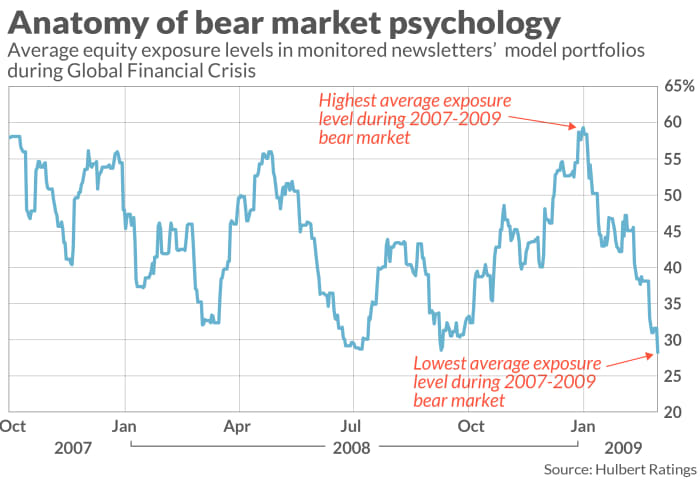Just because it feels like a bull market doesn’t mean it is a bull market. That’s important to point out because of how bullish investors became in the wake of the U.S. market’s two-month rally off of its June low. Many declared that a new bull market had begun.
It’s possible they’re right. But know that bursts of investor enthusiasm occur frequently during bear markets. This tendency to prematurely declare the bear market to be over is poorly understood, since many believe investors’ mood gradually declines during a bear market in a more or less straight line. If the investor consensus were to follow that path, the average investor would be most bullish at the beginning of the bear market and most bearish at its end.
That is typically not the case. Instead, investors during bear markets usually experience many manic-depressive episodes, oscillating between despair and exuberance. They often are most bullish near the end of a bear market, not the beginning, and it’s when their late-bear-market enthusiasm is dashed that they throw in the towel for good.
A perfect illustration of this progression of bear market sentiment is what happened during the 2007-2009 bear market. Take a look at the chart below, which reflects the average equity exposure level among the more than 500 model portfolios tracked by the Hulbert Financial Digest.

Note carefully that the average that is plotted in the chart is not the same as either of the stock market sentiment indexes that my firm calculates, which reflect the average exposure level among subsets of short-term market timers. The chart, in contrast, plots the average exposure level among all monitored newsletters, including those that say that they are not market timers. Interestingly, many of these buy-and-holders are closet market timers, and their equity exposure levels do vary over time.
Notice the pattern of higher highs and lower lows: Each of the 2007-2009 bear market’s several manic episodes was characterized by higher average bullishness than the prior one, just as each of the depressive episodes exhibited more despair than the prior one. As a result, the highest level of bullishness during the 2007-2009 bear market occurred right before the final low.
That highest level of bullishness occurred in January 2009, three months after the collapse of Lehman Brothers brought the world’s financial system to its knees, and six weeks after the CBOE’s Volatility Index, or VIX
VIX,
hit a previously unimaginable high of next 90. Surely, advisers told themselves, the worst was behind them. Yet the final low of the bear market was still two months away.
This tendency to be most bullish right before the bear market’s end is the mirror opposite of the psychological pattern underlying the classic saying “it’s darkest before the dawn.” In the case of bear market sentiment, one might say “things look brightest before they’re the darkest.”
This helps to explain why bear markets usually end in what’s called capitulation — a spasm of such deep despair that investors throw in the towel and swear off equities altogether. Up until capitulation occurs, investors are willing to give the stock market the benefit of the doubt.
In other words, the mood during capitulation isn’t just slightly more bearish than what prevailed immediately prior. It’s when investors’ eagerness to believe is dashed, once and for all, that their mood swings from extreme exuberance to extreme despair.
Not all past bear markets ended with a capitulation, but most did. In a recent email, Jack Schannep, founder of TheDowTheory.com advisory service, said that based on his proprietary measure of capitulation, the ends of “the last ten bear markets have been signaled by” capitulation.
The reason it’s important to understand this typical pattern of bear market psychology: Armed with the knowledge, you’ll be better able to resist your fellow investors’ mood swings. The late MIT economist Paul Samuelson famously once quipped that the stock market had predicted nine of the past five recessions. He could also have said the same during market rallies: the stock market has predicted nine of the past five bull markets.
Mark Hulbert is a regular contributor to MarketWatch. His Hulbert Ratings tracks investment newsletters that pay a flat fee to be audited. He can be reached at mark@hulbertratings.com
And don’t miss: Learn how to shake up your financial routine at the Best New Ideas in Money Festival on Sept. 21 and Sept. 22 in New York. Join Carrie Schwab, president of the Charles Schwab Foundation.
Read More:Bursts of bullish exuberance are common during bear markets — and it’s all too easy to get sucked in
2022-08-31 11:20:00
